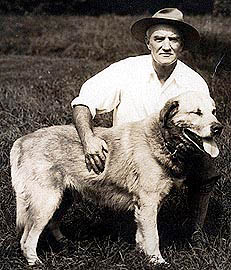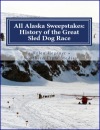 “Let me tell you about this man Walden.” These words, found in the introduction to Arthur Treadwell Walden’s classic book, A Dog-Puncher on the Yukon (Houghton Mifflin Co., 1928), are the reader’s invitation to meet one of the most respected and heralded pioneers of the Klondike and Alaskan gold rushes, a man who, as the Introduction explains, “…reached the country of the Yukon in the early part of ’96, when Circle City was the center and the Birch Creek mines the magnet.”
“Let me tell you about this man Walden.” These words, found in the introduction to Arthur Treadwell Walden’s classic book, A Dog-Puncher on the Yukon (Houghton Mifflin Co., 1928), are the reader’s invitation to meet one of the most respected and heralded pioneers of the Klondike and Alaskan gold rushes, a man who, as the Introduction explains, “…reached the country of the Yukon in the early part of ’96, when Circle City was the center and the Birch Creek mines the magnet.” 
Walden traveled north with his collie dog, Shirley, up the Inside Passage and over the Chilkoot Pass, down the Yukon River through the fearsome Whitehorse Rapids and downriver to Circle City, at that time “…the banner town of the interior.” He learned to drive dogs across the vast white wilderness and became a musher, “…making trips with freight and mail and passengers behind his dogs.” Walden would later write knowingly in what was a good description of himself: “The dog driver was a good deal like the old-fashioned sailor. He never expected to stay anywhere for any length of time. He was constantly thinking either of turning back or of striking off for some new region. he hood-winked himself with the delusion that he was out there for the money. In reality, it was the adventurous life which appealed to him.”
 From the Circle Mining District Arthur Walden traveled east to the Klondike when gold was discovered near Dawson City in 1897, and two years later, when gold was discovered in the black sand beaches of Nome, Walden traveled down the Yukon River to the new goldfields. Again from the Introduction to his book: “Here was a man who had the zeal to seek the utmost of new experience, the nerve to dare what most men would shrink from, the mental background to appreciate what he saw, and a sense of humor to lighten even the times when he flirted with death. And by good fortune, he hit upon the Alaska of the gold rush, unique, vivid, splashed with color like a bizarre canvas.” Walden’s adventurous tales and colorful descriptions of the north and its inhabitants gave his book an enduring quality, and it’s still considered a northland classic. The history is accurate because Arthur Walden was there, he lived the history, and he wrote what he knew to be true: “In comparing the richness of the Birch Creek Mines with the Klondike, it is interesting to know that a prospect at Birch Creek which had yielded twenty-five cents to the pan was considered above the average, while on the Klondike they found as much as five hundred and six hundred dollars to the pan.”
From the Circle Mining District Arthur Walden traveled east to the Klondike when gold was discovered near Dawson City in 1897, and two years later, when gold was discovered in the black sand beaches of Nome, Walden traveled down the Yukon River to the new goldfields. Again from the Introduction to his book: “Here was a man who had the zeal to seek the utmost of new experience, the nerve to dare what most men would shrink from, the mental background to appreciate what he saw, and a sense of humor to lighten even the times when he flirted with death. And by good fortune, he hit upon the Alaska of the gold rush, unique, vivid, splashed with color like a bizarre canvas.” Walden’s adventurous tales and colorful descriptions of the north and its inhabitants gave his book an enduring quality, and it’s still considered a northland classic. The history is accurate because Arthur Walden was there, he lived the history, and he wrote what he knew to be true: “In comparing the richness of the Birch Creek Mines with the Klondike, it is interesting to know that a prospect at Birch Creek which had yielded twenty-five cents to the pan was considered above the average, while on the Klondike they found as much as five hundred and six hundred dollars to the pan.” 
In 1902 Arthur Walden returned to New England and in 1904 he married his longtime friend and cousin by marriage, Katherine Sleeper, the daughter of a well-to-do Boston newspaper family. Kate owned the 1300-acre Wonalancet Farm and Inn in New Hampshire, and it was there Walden began raising and training sled dogs, and developed a new breed he called the Chinook, after a favorite dog from his gold rush days. He is credited for bringing the sport of sled dog racing to New England, and in 1927 the New England Sled Dog Club was founded at Wonalancet Farm, with Arthur Walden elected its first president.
In 1927 he helped train sled dogs and drivers for Admiral Richard E. Byrd’s Antarctic expedition. Walden was in charge of hauling supplies to Byrd’s base camp for the expedition. In the winter of 1927 the dogs, drivers and equipment began arriving at the Walden farm in Wonalancet, and in September, 1928, 97 dogs, along with nine drivers, sleds and equipment, traveled to Antarctica, arriving on Christmas Day. For the next three months Walden and his men freighted 650 tons of equipment and supplies from the ships to the base camp named “Little America,” nine miles inland. Byrd later wrote in his book about the expedition, Little America:  “Had it not been for the dogs, our attempts to conquer the Antarctic by air must have ended in failure. On January 17th, Walden’s single team of thirteen dogs moves 3,500 pounds of supplies from ship to base, a distance of 16 miles each trip, in two journeys. Walden’s team was the backbone of our transport. Seeing him rush his heavy loads along the trail, outstripping the younger men, it was difficult to believe that he was an old man. He was 58 years old, but he had the determination and strength of youth.”
“Had it not been for the dogs, our attempts to conquer the Antarctic by air must have ended in failure. On January 17th, Walden’s single team of thirteen dogs moves 3,500 pounds of supplies from ship to base, a distance of 16 miles each trip, in two journeys. Walden’s team was the backbone of our transport. Seeing him rush his heavy loads along the trail, outstripping the younger men, it was difficult to believe that he was an old man. He was 58 years old, but he had the determination and strength of youth.”
 In 1930 Admiral Byrd presented Arthur Walden a large photographic album containing 542 photographs, which was put together by Admiral Byrd and other members of the 1928-1930 expedition to the Antarctic.
In 1930 Admiral Byrd presented Arthur Walden a large photographic album containing 542 photographs, which was put together by Admiral Byrd and other members of the 1928-1930 expedition to the Antarctic.
Tragically, Arthur Treadwell Walden died on March 26, 1947, after saving his wife Kate from a fire in the kitchen of their farmhouse. They are both buried next to a lovely chapel near their former Wonalancet Farm.
Further reading:
• Arthur Treadwell Walden (1871-1947) Wonalancet New Hampshire Chinook Breeder, Dog Trainer, and Antarctica Dog Driver, from New Hampshire’s History Blog
• Who is Arthur Walden? An article in the Wonalancet Out Door Club Newsletter, Nov., 1994
• Arthur T. Walden, Dog Driver from the Klondike to Antarctica
• Arthur Walden and a Dog’s Life of Adventure, New England Historical Society
• The Life of Kate Sleeper, article on a message board, October, 2007
• Kate Sleeper Trail History, An article in the Wonalancet Out Door Club Newsletter, Dec., 1993
• Arthur Walden and the Chinook breed, article, Nov., 2007






























Pingback: A Dog-Puncher on the Yukon | Northern Light Media